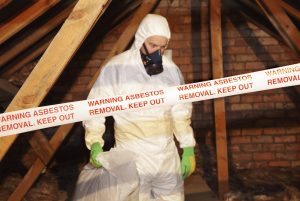Things to Know When Buying or Selling a House with Asbestos
7th June 2019Asbestos – a word with the ability to strike fear into any house buyer or seller. The highly fibrous material has been used to construct buildings for decades, but has since been outlawed completely (in 1999) in the UK. But what is it and what does its presence mean for homeowners and buyers?

What is Asbestos and Why is it Dangerous?
Asbestos is a heat-resistant fibrous mineral with an extensive range of potential uses. Historically, asbestos has been used for insulation, soundproofing and fireproofing buildings across the country. However, despite its many benefits, asbestos is highly dangerous and has since been banned as a construction material.
Although asbestos is relatively safe when left alone, if it’s disturbed, harmful fibres can be released into the air which could easily be inhaled by those nearby. Lung cancer, mesothelioma and asbestosis have all been linked to asbestos fibre inhalation. Although it should be noted that the symptoms of the aforementioned diseases, caused by exposure to asbestos fibres, could take several years to be realised.
Where Can Asbestos Be Found in the Home?
Commonly, when asbestos is identified within a home, it will have been most likely mixed with other materials to aid in its strength. For example, cement sheeting, corrugated roofing and decorative walls (such as Artex) were often made with asbestos, especially if the house was built or refurbished between 1950 and 1999. Asbestos can also be identified in water cisterns, pipe lagging, airing cupboards, loose fill insulation, gas pipes, around boilers, behind fuse boxes or in floor and ceiling tiles.
Which Houses Are Most Likely to Contain Asbestos?
Asbestos has been banned from the UK home building industry since 1999, although the use and import of brown and blue asbestos has been banned since 1985. Houses built after the millennium are highly unlikely to contain asbestos at all. Although, if you’re buying or selling a property that was built pre 1999, it would be worth having the house professionally inspected for the identification of asbestos, particularly in floors, ceilings and out-buildings (such as garden sheds and garages).
Asbestos in House You Want to Buy or Sell? Here’s What to Do
For the Buyer:
In the unfortunate event that asbestos has been identified in the house survey, the best thing to do would be to keep your purchase on track. You should then speak to a professional who specialises in the identification of asbestos, just to get some solid confirmation. If your worst fears are then confirmed, you should arrange to have the material safely and responsibly removed by highly accredited and greatly experienced specialists. Do not attempt to remove or dispose of any asbestos yourself.
However, if it’s proven that the seller was aware of the asbestos, yet didn’t notify you of the danger, they could be held liable for a misleading omission. This means that they will be made to pay for the removal and disposal of any asbestos that’s found, as well as other associated costs.
For the Seller:
If asbestos has been identified in a house you’re trying to sell, it’s imperative that the appropriate steps are taken to safely and responsibly remove the material from your house completely. It’s just as important to ensure the asbestos is disposed of properly as well and by fully accredited professionals.
If your buyer were to find out that you were aware of the presence of asbestos in and around the property and you either didn’t notify them or take steps to have it safely removed, you could be held liable for a misleading omission, meaning that you would have to pay for the removal and disposal of any asbestos that was found, as well as any other associated expenses.
Do not attempt to remove or dispose of any asbestos yourself. Always consult a fully accredited specialist if you wish to take action.
Here at Asbestos Waste Solutions, we strongly believe that a safe, reliable, responsible approach to collecting and disposing of asbestos products is absolutely imperative. Our knowledgeable team of experts are proud to provide a fully comprehensive, completely reliable service. If you suspect that you may be at risk or require more information, contact us today – we’re always here to help.
This entry was posted in Asbestos in the Home. Bookmark the permalink.

 Follow
Follow